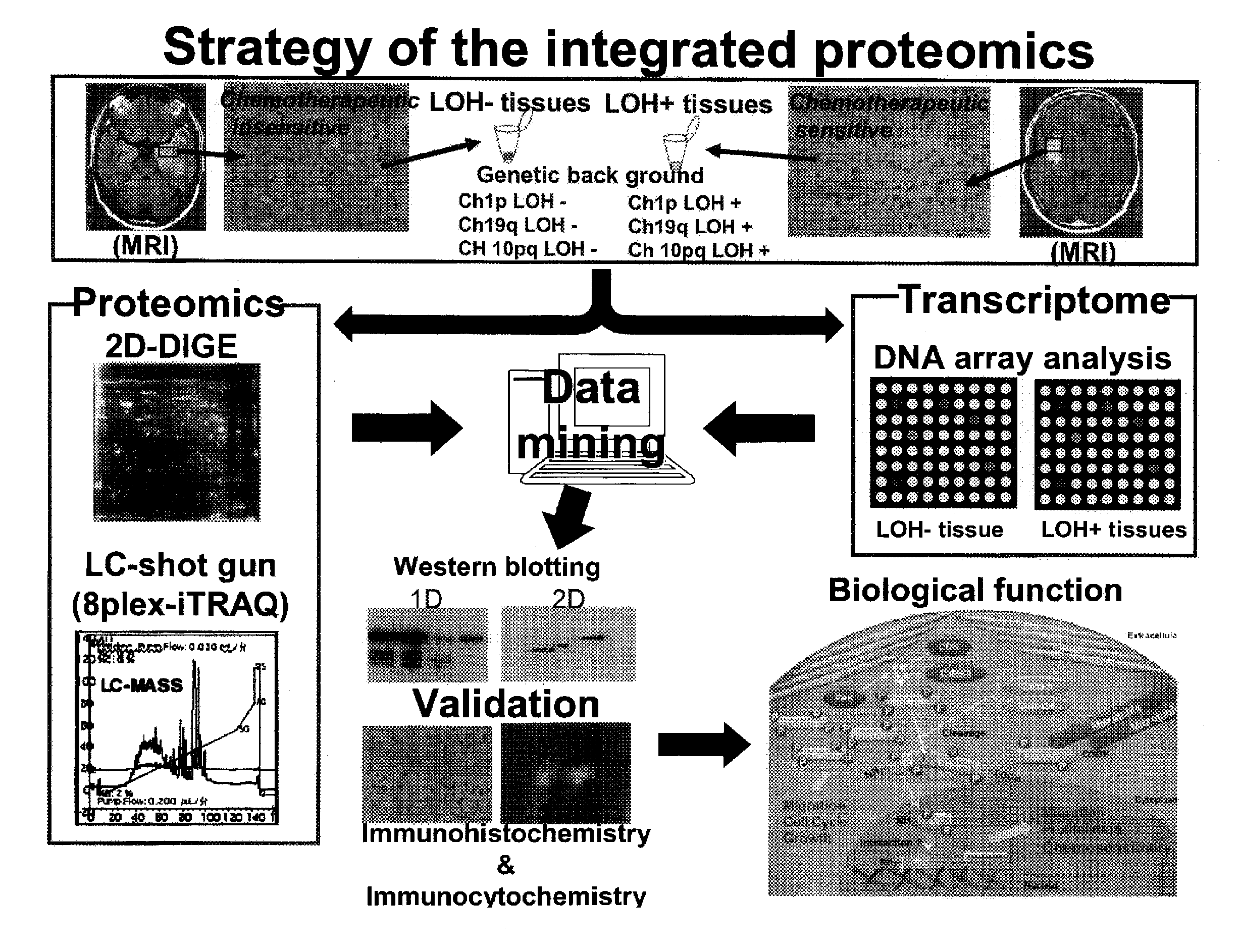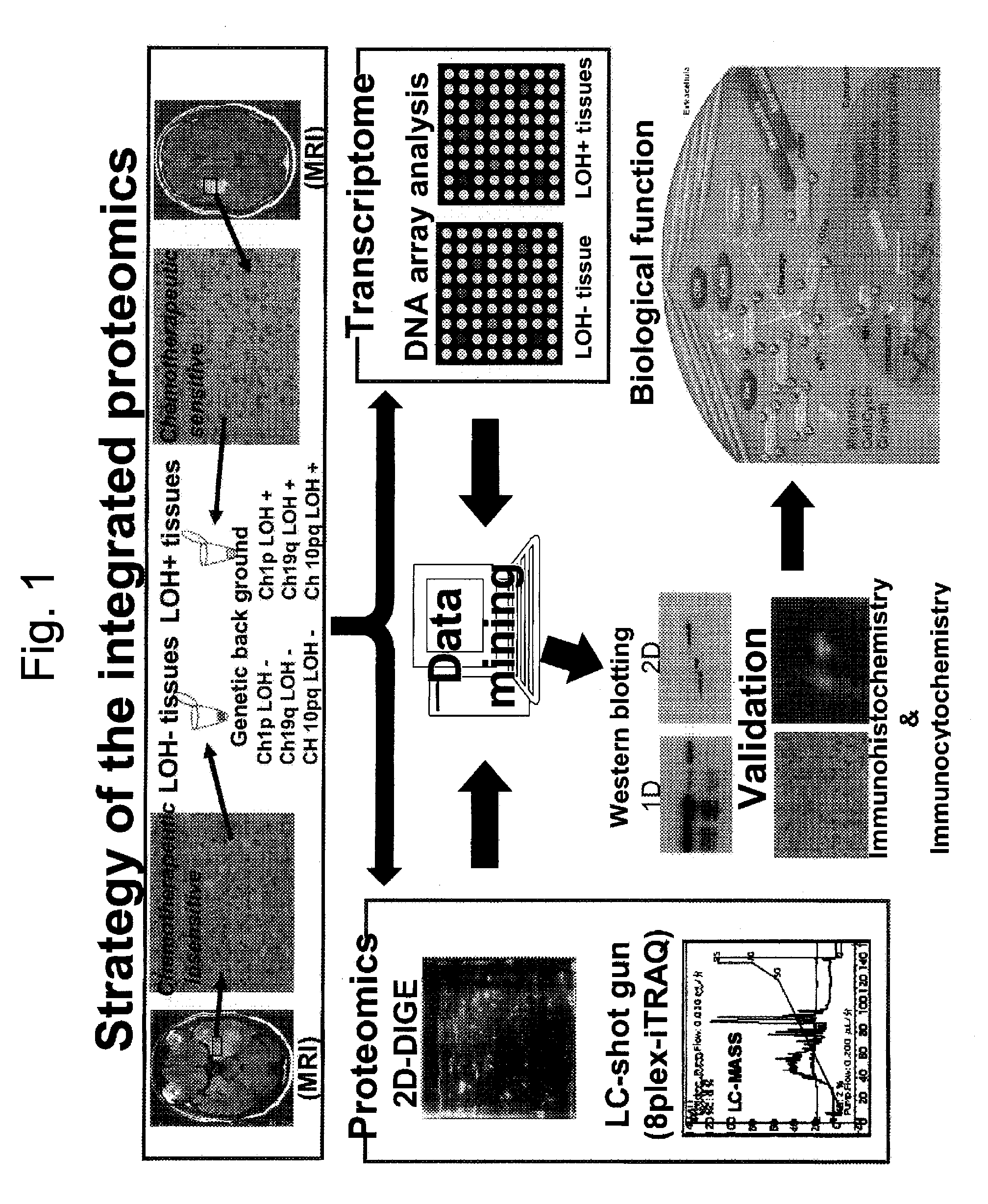Method for generating data set for integrated proteomics, integrated proteomics method using data set for integrated proteomics that is generated by the generation method, and method for identifying causative substance using same
a technology of integrated proteomics and data sets, applied in the field of integrated proteomics, can solve the problems of inability to directly involve gene information, inability to develop solely methods for the treatment and prevention of diseases such as cancer, and inability to apply conventional proteomic analyses so intelligently. to achieve the effect of effective application
- Summary
- Abstract
- Description
- Claims
- Application Information
AI Technical Summary
Benefits of technology
Problems solved by technology
Method used
Image
Examples
example 1
Strategy of a United Proteomics
[0198]Samples to be used for this example were collected from brain tumor tissues of patients with anaplastic oligodendroglioma / astrosystome (AO / AOA) obtained by surgical operations and then subjected to a histopathologic examination to classify a type of the LOH. Then, from these samples, proteins and mRNAs were extracted concurrently, and they were subjected to two kinds of proteomics analyses, one being the 2D-DIGE analysis and the iTRAQ analysis as well as the other being the DNA microarray analysis. All molecules demonstrating differences in expression levels were identified, and the expression levels of the proteins and the mRNAs were analyzed by an in silico united data mining, thereby verifying biological functions of those molecules in the glioma cells.
LOH Analysis Step:
[0199]The LOH analysis step is involved in a classification of the brain tumor samples to be used for an object of analysis by the presence or absence of the LOH.
[0200]The brai...
example 2
[0221]In this example, the tissue lysates used in Example 1 were subjected to the two-dimensional electrophoresis analysis and the blotting analysis of the band having absorbance at 420 nm for 1 hour using a polyvinylidene fluoride (PVDF) membrane having a pore size of 0.2 μm. The PVDF membrane was stained with simply blue and the vimentin spots were cut off for sequencing, followed by drying in air. The N-terminal amino acid sequence was determined by Edman degradation using a BLAST program compared with the vimentin sequence in the NCBI database.
Immunohistochemical Analysis of Vimentin:
[0222]By focusing on vimentin as an important molecule that was observed by the GO and KeyMolnet analyses as upregulating its expression variation amount significantly, its expression variation amount was verified by an immunohistological staining method and Western blotting. The experiment was carried out by subjecting the same patient-derived tissues as used for the integrated proteomics analysis ...
example 3
[0256]In this example, there were used cell lines derived from two kinds of cells (SQUU-A cells and SQUU-B cells), respectively, which were collected from tongue cancer tissues at local recurrence sites of Japanese women and had properties different from each other. The SQUU-A cells were low-metastatic cancer cells without causing expansive proliferation and intravascular infiltration as well, while the SQUU-B cells were high-metastatic cancer cells with expansive proliferation and intravascular infiltration as well. The SQUU-B cells grow in a more predominant way under mixed culture conditions than the SQUU-A cells.
[0257]In the SQUU-B cells, the molecules which upregulated their expression levels, that is, which were considered to be involved in metastaticity or grew predominantly under mixed culture conditions under which the SQUU-A cells were mixed therewith, were selected for analyses using the proteomic analysis and the DNA microarray analysis methods. The results of the proteo...
PUM
| Property | Measurement | Unit |
|---|---|---|
| v/v | aaaaa | aaaaa |
| temperature | aaaaa | aaaaa |
| pH | aaaaa | aaaaa |
Abstract
Description
Claims
Application Information
 Login to View More
Login to View More - R&D
- Intellectual Property
- Life Sciences
- Materials
- Tech Scout
- Unparalleled Data Quality
- Higher Quality Content
- 60% Fewer Hallucinations
Browse by: Latest US Patents, China's latest patents, Technical Efficacy Thesaurus, Application Domain, Technology Topic, Popular Technical Reports.
© 2025 PatSnap. All rights reserved.Legal|Privacy policy|Modern Slavery Act Transparency Statement|Sitemap|About US| Contact US: help@patsnap.com



